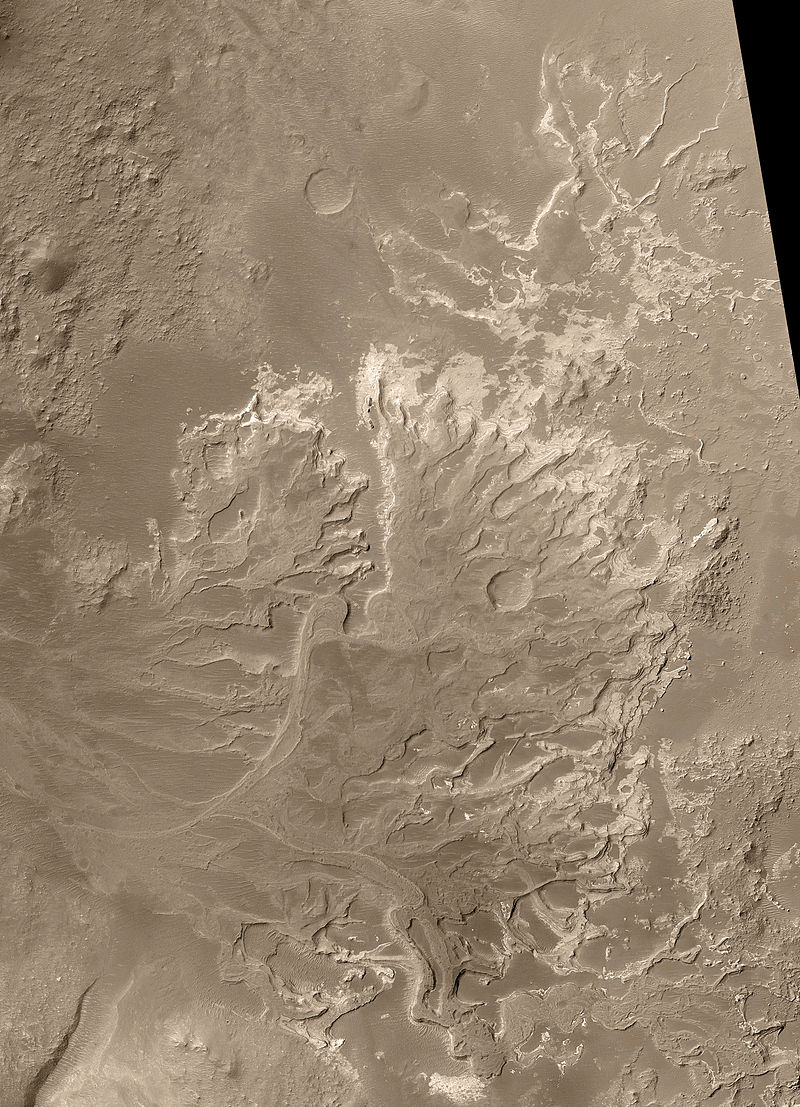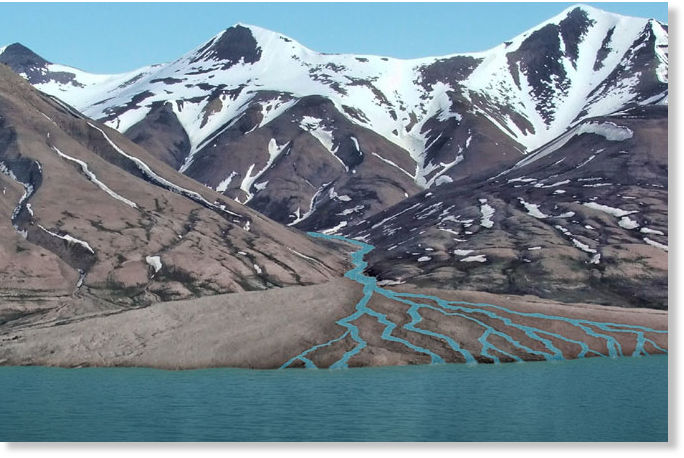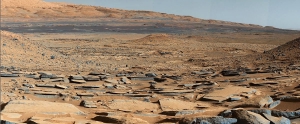
it will bring to and maintain the life of the new Martians.
When we talk about the subject of water on Mars, we must distinguish between water in the past and water nowadays. In the past, it is associated with life that found a favorable environment on Earth; nowadays, it is associated with the needs that the men who will go to the Red-planet will have to satisfy.
In the past, it is now indisputable that liquid water ran on Mars, in abundance. As on Earth, it was most likely lacking at the origin, as the planet was formed under the "ice line", beyond which the violent young Sun had repelled all the volatile elements of its protoplanetary disk. But the system in formation was by definition unstable and the "Great Tack" of Jupiter and Saturn (spiraling of Jupiter towards the Sun and then pulling backward together with Saturn) very likely brought a considerable amount of water from the outer part of the Asteroid Belt (the one that lies beyond the ice line) and also from the Kuiper Belt (beyond Neptune), as Saturn returning to its orbit of origin (actually a little further), rejected Neptune Beyond Uranus in this Belt made of objects rich in water ice (and perhaps much further away, "Planet 9" which could have been where Saturn is orbiting today itself...but this is another story !).
 Still, liquid water probably filled the Northern-Lowlands and large depressions in the Southern-Highlands (Hellas and Argyre basins, Eridania Sea, many craters). A water cycle existed, with evaporation under a thick primitive atmosphere and generating a powerful greenhouse effect by its very high carbon dioxide content. It rained and snowed and rivers flowed in the intertropical zone towards the lowest areas; waterlogged soil released cataclysmic flows on the occasion of the making of huge volcanic massifs, especially that of Tharsis which by its mass triggered gigantic faults (Valles Marineris). For a few hundred million years, in a warm soil environment due to the recent accretion of the planet, water hydrated the rocks and transformed them. It was at this time that life could have begun on Mars but nothing is sure. We can say that the "ingredients" were there but subtle differences in the environment may have "made the difference". Perhaps also, did Time not "left enough time to time". Indeed, already around 4 billion years ago, Martian atmosphere not retained by a too weak gravity and unprotected by a sufficiently powerful magnetosphere, had considerably dwindled (pressure similar to that of today). But the planet was young, the crust still thin and the volcanic emissions of gas and dust, important and frequent. The second Martian eon, the Hesperian, named Theiikian, the Age of Sulfur, by the astrophysicist Jean-Pierre Bibring, prolonged the conditions favorable to liquid water on the surface until about 3.5 billion years ago. Then volcanic episodes became more and more exceptional even though they were more and more violent (thickening of the planetary crust). To sum up, the planet turned into an arid desert at that time and recovered "habitable" conditions only intermittently with more and more delays between the active periods which were shorter and shorter. The nagging question that arises since the exploration of Mars began is therefore whether life could start before aridity generalized (life started on Earth between 4 and 3.7 billion years ago).
Still, liquid water probably filled the Northern-Lowlands and large depressions in the Southern-Highlands (Hellas and Argyre basins, Eridania Sea, many craters). A water cycle existed, with evaporation under a thick primitive atmosphere and generating a powerful greenhouse effect by its very high carbon dioxide content. It rained and snowed and rivers flowed in the intertropical zone towards the lowest areas; waterlogged soil released cataclysmic flows on the occasion of the making of huge volcanic massifs, especially that of Tharsis which by its mass triggered gigantic faults (Valles Marineris). For a few hundred million years, in a warm soil environment due to the recent accretion of the planet, water hydrated the rocks and transformed them. It was at this time that life could have begun on Mars but nothing is sure. We can say that the "ingredients" were there but subtle differences in the environment may have "made the difference". Perhaps also, did Time not "left enough time to time". Indeed, already around 4 billion years ago, Martian atmosphere not retained by a too weak gravity and unprotected by a sufficiently powerful magnetosphere, had considerably dwindled (pressure similar to that of today). But the planet was young, the crust still thin and the volcanic emissions of gas and dust, important and frequent. The second Martian eon, the Hesperian, named Theiikian, the Age of Sulfur, by the astrophysicist Jean-Pierre Bibring, prolonged the conditions favorable to liquid water on the surface until about 3.5 billion years ago. Then volcanic episodes became more and more exceptional even though they were more and more violent (thickening of the planetary crust). To sum up, the planet turned into an arid desert at that time and recovered "habitable" conditions only intermittently with more and more delays between the active periods which were shorter and shorter. The nagging question that arises since the exploration of Mars began is therefore whether life could start before aridity generalized (life started on Earth between 4 and 3.7 billion years ago).
If it started, it could have kept going in a very primitive way, in the underground, where the water was necessarily present since there is still now abundant water ice, under a thin layer of regolith, everywhere, even in the intertropical zone.
 In this context, we pass to present days and the possibility offered by the planet, because of this water, to provide for the needs of a human population. Bases will be built near water deposits. Martian water is somewhat "heavy" (high percentage of deuterium – twice that of Earth water - compared to hydrogen) because the lighter elements tend to be lost by sublimation in the atmosphere and the latter then in space, but water will remain consumable and usable for all kinds of needs (including producing methane from its hydrogen, using the Sabatier’s reaction). We must not imagine that Man could behave on Mars, as carefree from the point of view of his consumption as he has been on Earth. Mars is a fragile planet, more than Earth; its resources are quite limited. Faster than on Earth, we will not be able to do just anything we want. As a consequence, we will not be allowed by “Nature” to let our population explode, and it will be necessary, from the beginning of the human presence, to recycle everything as much as possible. We will be used to it because during the first inhabited missions, when equipment and chemicals will be by necessity very rare (it will be necessary to import from the Earth almost any transformed product and start as soon as possible producing them, with great difficulties), Man will have applied to himself and his actions the rule of “you shall not spoil”, anything. From this point of view Mars will be an ecological laboratory and the Martians an ecological example for the Earthlings.
In this context, we pass to present days and the possibility offered by the planet, because of this water, to provide for the needs of a human population. Bases will be built near water deposits. Martian water is somewhat "heavy" (high percentage of deuterium – twice that of Earth water - compared to hydrogen) because the lighter elements tend to be lost by sublimation in the atmosphere and the latter then in space, but water will remain consumable and usable for all kinds of needs (including producing methane from its hydrogen, using the Sabatier’s reaction). We must not imagine that Man could behave on Mars, as carefree from the point of view of his consumption as he has been on Earth. Mars is a fragile planet, more than Earth; its resources are quite limited. Faster than on Earth, we will not be able to do just anything we want. As a consequence, we will not be allowed by “Nature” to let our population explode, and it will be necessary, from the beginning of the human presence, to recycle everything as much as possible. We will be used to it because during the first inhabited missions, when equipment and chemicals will be by necessity very rare (it will be necessary to import from the Earth almost any transformed product and start as soon as possible producing them, with great difficulties), Man will have applied to himself and his actions the rule of “you shall not spoil”, anything. From this point of view Mars will be an ecological laboratory and the Martians an ecological example for the Earthlings.
An original use of water could be applied in building. We can easily make “duricrete” (very hard cement) simply by wetting the regolith, but above all, it is conceivable that habitable domes would be covered with ice blocks in plastic envelopes (to avoid sublimation when temperature rises above freezing). These layer of ice, wrapping the geodesic spheres made of (Martian) metal of our habitats, would present the advantage of exerting some counterpressure versus the pressure of inner breathable air, alleviating efforts on the structure and blocking solar radiations, rich in protons such as hydrogen’s water.
You see. We can do a lot of things with water and, by the force of necessity and scarcity, creativity will be continually stimulated on Mars.
Mars is not just any celestial body, it has become a geological and geographical object.
Outside the Earth, Mars is now the planet that is the best-known celestial body. This is because it is the most accessible and the most similar to the Earth.
Mars is similar to the Earth in the sense that it is a rocky planet that has been formed near the Earth, at the same time, with the same material and in the habitable zone of the Sun (even if located at its margin). The difference is mainly its mass and this has had very important consequences. After the brilliant demonstration of the astrophysicist Alessandro Morbidelli, most people agree on his hypothesis that the giant gas planet Jupiter began its accretion beyond the ice line (about 3.5 AU) before the planets of the inner solar system begin to aggregate their own matter. When it was massive enough, it began to spiral slowly toward the sun in the process of absorbing matter into her Hill sphere. It did so by attracting Saturn in its wake (sending matter in its direction within the framework of a favorable orbital resonance) and it was only when the two planets entered another resonance stabilizing them, that the couple was pulled back to the outside of the system (the “grand tack”). At that time, Jupiter had reached a distance of 1.5 AU from the Sun, near where Mars would eventually evolve latter and much of the material that could have been used by Mars to grow, had been swallowed by the monster. If Saturn had not somehow “retained” Jupiter, there would be no rocky planet in our inner solar system but, just like in many star systems, a hot Jupiter orbiting very close to its star. When Mars was formed, it could only gather the matter that remained at its distance from the Sun. The result is that the mass of Mars is only one tenth of that of the Earth (or Venus).
The consequences are numerous:
First, the amount of radioactive material decaying inside the planet (thorium, potassium and uranium) is less important than it should have been and the heat produced by this decay has been lower; as a result, the planet has cooled faster than the Earth and its crust has thickened more rapidly; secondly, the gravitational attraction generated by the mass has been weaker; as a result, the planet has lost most of its atmosphere quickly. It was already about the same as today, about 4 billion years ago. Many subsequent volcanic episodes periodically restored a relatively thick atmosphere, but when volcanism calmed down (relatively faster than on Earth due to the thick crust), about 3.5 billion years ago, the volume and the atmospheric pressure level remained low most of the time. Low atmospheric pressure means a very limited possibility of liquid water, and abundant radiation reaching the ground. Low gravity had another negative consequence: it probably attracted fewer asteroids and comets loaded with ice; which resulted in less water on the ground. This means that the water content (not recycled by plate tectonics) of the planet was perhaps less than that of the Earth, which led to less ductility of the crust and a shorter period of plate tectonics floating on the magma.
Without plate tectonics, the rocks could not be “kneaded” and enriched continuously, and volcanism had to be more catastrophic than permanent and more stable geographically (Tharsis) than on Earth as it was very difficult for lava to find a way to the surface.
The advantage for us is that, after a relatively short period (a few hundred million years) during which Mars was covered with liquid water under a rather thick atmosphere, it became arid, except for some exceptional revivals, and maintains the image of an ancient hydrated land, very little modified by erosion (apart from consequences of intermittent volcanism and constant wind erosion).
Today, Mars presents two quite different parts because of a spectacular "crustal dichotomy" (perhaps the accretion of a last giant planetoid not completely spread out on its surface). By and large, the surface of the northern hemisphere is smooth and is several kilometers (up to more than 4 km) below the datum, its mean altitude level. It is mostly covered with lava (there are huge volcanoes on the periphery of the datum) and debris from catastrophic floods from huge faults and rivers in the Southern Highlands. The surface of the Southern hemisphere is much higher than the datum and it is very craterized and much older. It is therefore in the Southern hemisphere that we can find most of the oldest surface of Mars, that which remains a testimony of the time when there was running water on the planet over very long periods of time. There are even areas where fossil local magnetic fields can still be observed. Unfortunately the highlands are more difficult to access (from space) than the lowlands because the terrain is littered with obstacles (craters) and being higher, is covered by a thinner atmosphere, hence offering less lift capacity to spaceships coming from Earth.
For future astronauts a positive characteristic is the presence of permanent ice just covered by a thin layer of regolith, in many areas of the planet, even the intertropical zone. This is due to the fact that the planet is not stabilized like Earth by a sizable Moon and it changes obliquity about every 140.000 years. There will be no need to go to the poles to find ice!



